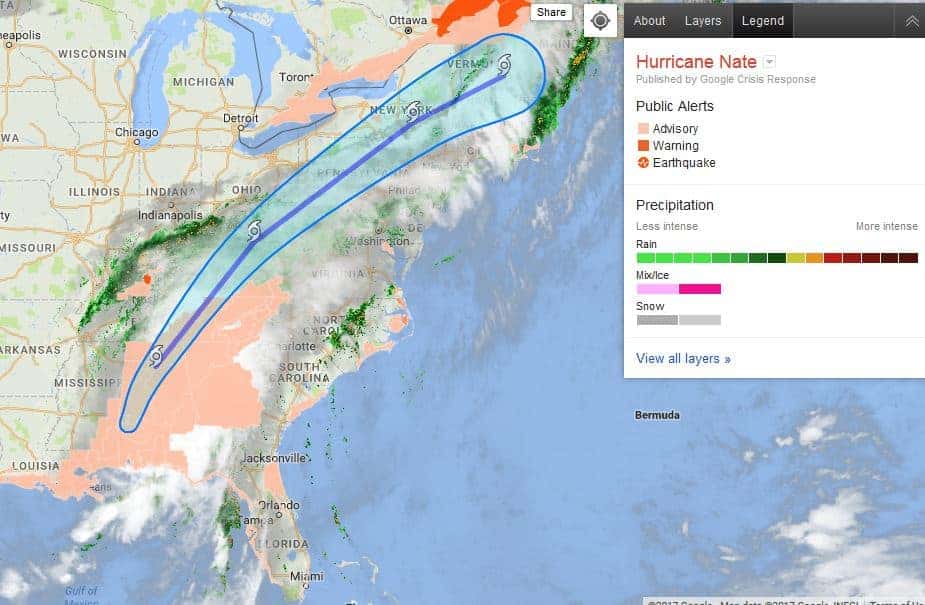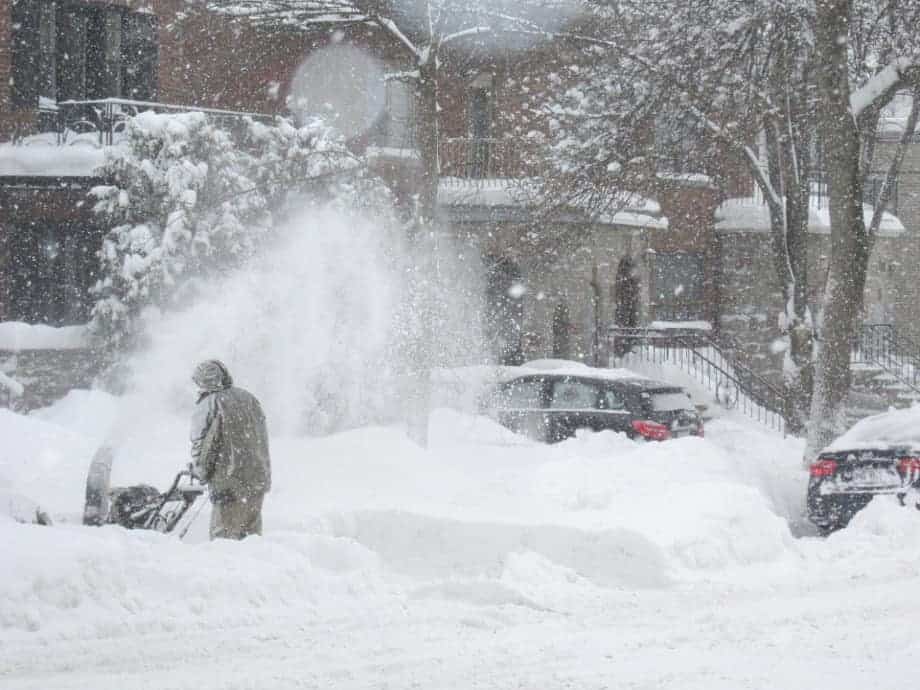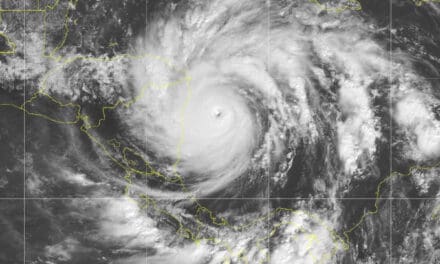Fourteenth Named Storm of the Atlantic Hurricane Season Makes Landfall at Biloxi, Mississippi—Weakens Rapidly
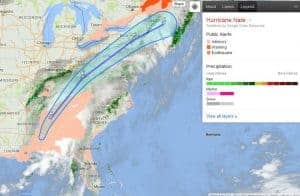
Tropical Cyclone Nate will Move to Northeast Over the Next 48 Hours bringing strong winds and heavy rain (click for Google Public Alerts.)
Update Sunday, October 8, 2017, 11:00AM EDT Hurricane Nate made landfall last night as a Category 1 hurricane—first at the mouth of the Mississippi River at 8:05 p.m. CDT and again at Biloxi, Mississippi at 11:54 p.m. Power outages spread rapidly across the region as Nate moved inland with high winds and a storm surge that flooded streets and roads.
Nate had weakened to a tropical storm by 4:00 a.m. but continued to cause widespread power outages along its path. As up this update, more than 100,000 customers were without power in Alabama and Mississippi while the storm continued to weaken. Heavy rains and storm surge continue to affect the region as Nate moves to the northeast. In the National Hurricane Center’s 10:00 a.m. EDT Discussion Update, Nate was downgraded from a Tropical Storm to a Tropical Depression with 30-35 MPH sustained winds. Heavy rainfall continues.
No deaths or injuries attributed to Hurricane Nate were reported as of this update. FEMA Director Brock Long reported that 85 percent of the agency’s resources are deployed in response to hurricanes Harvey, Irma, Maria, and Nate, both in the United States and in Puerto Rico and the Virgin Islands.
Key Messages:
- Do not attempt to drive through flooded areas. Moving water on roads can sweet a vehicle away.
- Beware of downed power lines. Lines on the ground may pose an electrocution or shock hazard.
- Only operate portable generators outside. Never run a generator in your home or in your garage. Follow Portable Generator Safety Guidelines.
- Never enter moving flood water. It only takes 6 inches of moving water to knock a person over and carry them away.
- Wind and Rain from the Tropical Depression will continue through the Southeast and into the Northeast bringing additional outages and localized flooding. Listen to local officials and news reports for updates.
Portable Generators for Emergency Power
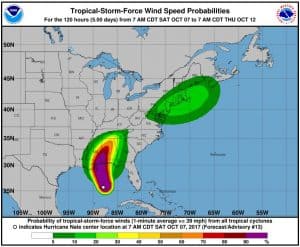
Storm Force Wind Probabilities for Hurricane Nate Extend Well Inland and include Mississippi, Alabama, Georgia, and Tennessee.
Update Saturday, October 7, 2017, 4:00AM EDT: Nate has transitioned to a Category 1 hurricane overnight and is moving toward the gulf coast at 22 MPH.
Key Messages from the NHC:
- Hurricane Warnings and Tropical Storm Warnings are in effect for the Louisiana, Alabama, Mississippi, and Florida Gulf Coast. Nate will make landfall sometime this evening east of New Orleans. Additional Tropical Storm Warnings and Watches are in effect for southeastern Mississippi and Western Georgia.
- Check your evacuation zone. Hurricane Nate will bring a life-threatening storm surge of 7 to 11 feet along portions of the Louisiana and Mississippi Coast. A Surge Warning is in effect from Morgan City, Louisiana to the Okaloosa/Walton county line in Florida. Heed evacuation warnings.
- Rush Preparations to protect life and property. Nate will probably strengthen to Category 2 before it makes landfall. If you are evacuating, complete your preparations as soon as possible and leave using designated evacuation routes.
- Expect heavy rainfall and flooding from the central Gulf Coast to the Deep South, portions of the Tennessee Valley, and into Appalachia.
Resources Below – Find Links to Government Websites Below.
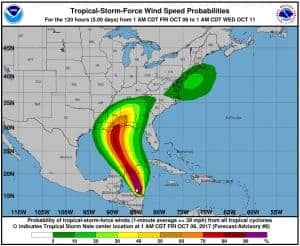
TS Nate is forecast to make landfall near New Orleans, LA as a hurricane late on Saturday or early Sunday
Update Friday, October 6, 2017 4:00AM EDT: Tropical Storm Nate is beginning to strengthen as it moves into the Gulf of Honduras Early this morning. Investigation by a Hurricane Hunter Aircraft found the central pressure at 999mb and initial intensity of 44 MPH.
The storm is moving faster than previously forecast leaving less time for preparation. Meanwhile, the guidance models have tightened and are now in closer agreement, though some uncertainly about the exact Gulf Coast landfall location remains.
Key Messages from National Hurricane Center
- Nicaragua, Honduras, Costa Rica, Panama, and Belize should expect heavy rains, flash flooding, and mudslides through tonight.
- Nate could reach near hurricane strength before it crosses the Yucatan Peninsula today with impacts from wind, storm surge, and heavy rainfall. A tropical storm warning and hurricane watch are in effect.
- Tropical Storm After strengthening further over the Gulf of Mexico, Hurricane Nate will reach the US Coast either late Saturday October 7 or very early Sunday Morning October 8.
- Tropical Storm watches, Hurricane Watches and Storm Surge Watches are in effect from Intercoastal City, Louisiana through Miramar Beach, Florida
- Residents along the watch area should listen to local officials and make immediate preparations for the storm’s arrival before early Saturday evening.
Read the complete discussion Number 8 at the NHC .
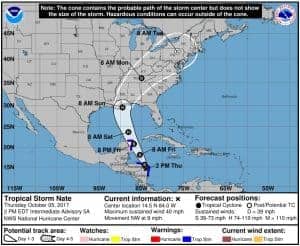
TS Nate Expected to Strengthen to a Hurricane Before Making Gulf Coast Landfall on Sunday, October 8.
Thursday, October 5, 2017: A region of thunderstorm activity in the southwestern Caribbean Sea showed signs of intensification and organization earlier this week. By Wednesday morning, October 4, it had enough strength for the National Hurricane Center to upgrade it to Tropical Depression Sixteen. In the October 5, 11:00AM EDT Discussion, initial intensity was increased to 35 knots and named Tropical Storm Nate.
Nate shows signs of rapid intensification, though interaction with land as it moves north will probably keep it below hurricane strength. Once it reaches the warm waters of the Gulf of Mexico and conditions favorable for further development, Nate is expected to become a hurricane.
Bookmark This Post for Quick Access to Updates
Residents and Businesses along the Gulf Coast from Louisiana to the Florida Panhandle should begin preparations to put their emergency hurricane plan into action. It is too early to predict the exact path of the storm and when it will make landfall.
The storm is expected to make landfall in approximately 72 hours, or just three days, which leaves a small window for residents and businesses to prepare. Much greater detail and forecast accuracy should become available in 24 to 36 hours.
72 Hour Preparation Check List
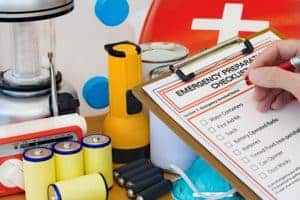
Make Immediate Preparations in Advance of the Storm’s Arrival
Discuss your storm preparations with your family and make everyone a part of it including young children. Being a part of action reduces fears.
- Determine if you live in an evacuation zone and prepare to evacuate if necessary
- Fill water containers with a 5-day supply of water—5 gallons per person.
- Stock up on non-perishable food for at least 5-days
- Review emergency plans on your local government websites for specific disaster planning information.
- Top off vehicle fuel tanks now and limit use to conserve fuel.
- Fill fuel containers for portable generators and water pumps. A five-day supply of gasoline is ideal, but obey local laws regarding fuel storage. Do not store fuel inside the house. Never run a portable generator inside the house. Even with ventilation, carbon monoxide poisoning is a certainty.
- Perform required maintenance on portable generators now so they are available for use during storm related outages. Change the oil, oil filter, and air filter, and install new spark plugs. Keep enough supplies on hand for at least two additional changes.
- Check local news and government information websites (see below) frequently for information updates.
- Make Plans Now for your Pets. They need food and water too. If you evacuate, Don’t Leave Them Behind.
Top Four Portable Generators for Emergency Power
Emergency and Disaster Management – Florida
Florida Division of Emergency Management
Florida Emergency Information via Social Media – Florida State Emergency Response Team
Emergency and Disaster Management – Louisiana
Governor’s Office of Homeland Security and Emergency Preparedness
Louisiana Emergency Information via Social Media
Emergency and Disaster Management – Mississippi
Mississippi Emergency Management Agency — MEMA
Emergency and Disaster Management – Alabama
Alabama Emergency Management Agency – Alabama EMA
Emergency and Disaster Management – Georgia
Georgia Emergency Management and Homeland Security Agency
Emergency and Disaster Management – Tennessee
Tennessee Emergency Management Agency – TEMA
Be prepared to evacuate if the order is given and take your emergency supplies with you.
Additional Information
Information on preparing for a Hurricane.
- 10 Tips to Survive a Hurricane Disaster
- Hurricane Preparedness: Know Your Risks – Make Your Plans
- Hurricane Preparedness: Disaster Planning and Preparation
- Hurricane Preparedness: Prepare Your Home Against a Hurricane
- Hurricane Preparedness: Your Completed Disaster Preparation Plan
How to Use a Portable Generator For Emergency Power
Information on the storm will be updated as it becomes available.

